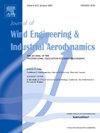Wind-induced loads on canopies attached to building walls
IF 4.2
2区 工程技术
Q1 ENGINEERING, CIVIL
Journal of Wind Engineering and Industrial Aerodynamics
Pub Date : 2025-02-02
DOI:10.1016/j.jweia.2025.106019
引用次数: 0
Abstract
Very limited studies have been carried out on wind loading on attached canopies. Current versions of the Canadian code and the American standard provide a procedure for calculating the wind loading on attached canopies. These provisions include a chart to find out both upward and downward wind pressures on the attached canopy. Most past and recent studies regarding this topic have been confined to low-rise buildings. Also, the effect of canopy width has not been investigated thoroughly. Thus, structural engineers are asking for guidance in the estimation of wind loads that may act on canopies in tall buildings. This paper presents a study on the effect of wind loading on attached canopies in medium-height and tall buildings. In this study, high-rise (37 m) buildings with canopies attached to the wall at different heights were tested. In addition, canopies with different widths were also tested. The test program, which was carried out in the Wind Tunnel Laboratory of Concordia University, Montreal, shows that canopies attached at the top of a tall building may experience 70% more suction than that of a low-rise building. In addition, this paper also presents the effect of building height, canopy height, wind angle of attack and effect of considered effective area on wind loading on canopies, which will help structural engineers better understand the behavior of canopies under wind loads both in low-rise and taller buildings. Design provisions for appropriate wind forces for canopies in taller buildings are also provided to help structural engineers.
附在建筑物墙壁上的檐篷上的风致荷载
对附加檐篷的风荷载进行了非常有限的研究。当前版本的加拿大规范和美国标准提供了计算附加檐篷风荷载的程序。这些规定包括一个图表,以找出向上和向下的风压在附加的顶篷。关于这一主题的大多数过去和最近的研究都局限于低层建筑。此外,冠层宽度的影响还没有得到充分的研究。因此,结构工程师要求在估计可能作用于高层建筑檐篷的风荷载方面提供指导。本文研究了风荷载对中高层建筑附盖结构的影响。在这项研究中,高层(37米)的建筑在不同的高度与墙连接的檐篷进行了测试。此外,还对不同宽度的冠层进行了试验。这项在蒙特利尔康考迪亚大学风洞实验室进行的测试表明,高层建筑顶部的顶篷比低层建筑的顶篷承受的吸力要大70%。此外,本文还分析了建筑高度、顶篷高度、风攻角和考虑有效面积对顶篷风荷载的影响,有助于结构工程师更好地了解低层和高层建筑顶篷在风荷载作用下的行为。还提供了高层建筑物中檐篷适当风力的设计规定,以帮助结构工程师。
本文章由计算机程序翻译,如有差异,请以英文原文为准。
求助全文
约1分钟内获得全文
求助全文
来源期刊
CiteScore
8.90
自引率
22.90%
发文量
306
审稿时长
4.4 months
期刊介绍:
The objective of the journal is to provide a means for the publication and interchange of information, on an international basis, on all those aspects of wind engineering that are included in the activities of the International Association for Wind Engineering http://www.iawe.org/. These are: social and economic impact of wind effects; wind characteristics and structure, local wind environments, wind loads and structural response, diffusion, pollutant dispersion and matter transport, wind effects on building heat loss and ventilation, wind effects on transport systems, aerodynamic aspects of wind energy generation, and codification of wind effects.
Papers on these subjects describing full-scale measurements, wind-tunnel simulation studies, computational or theoretical methods are published, as well as papers dealing with the development of techniques and apparatus for wind engineering experiments.

 求助内容:
求助内容: 应助结果提醒方式:
应助结果提醒方式:


